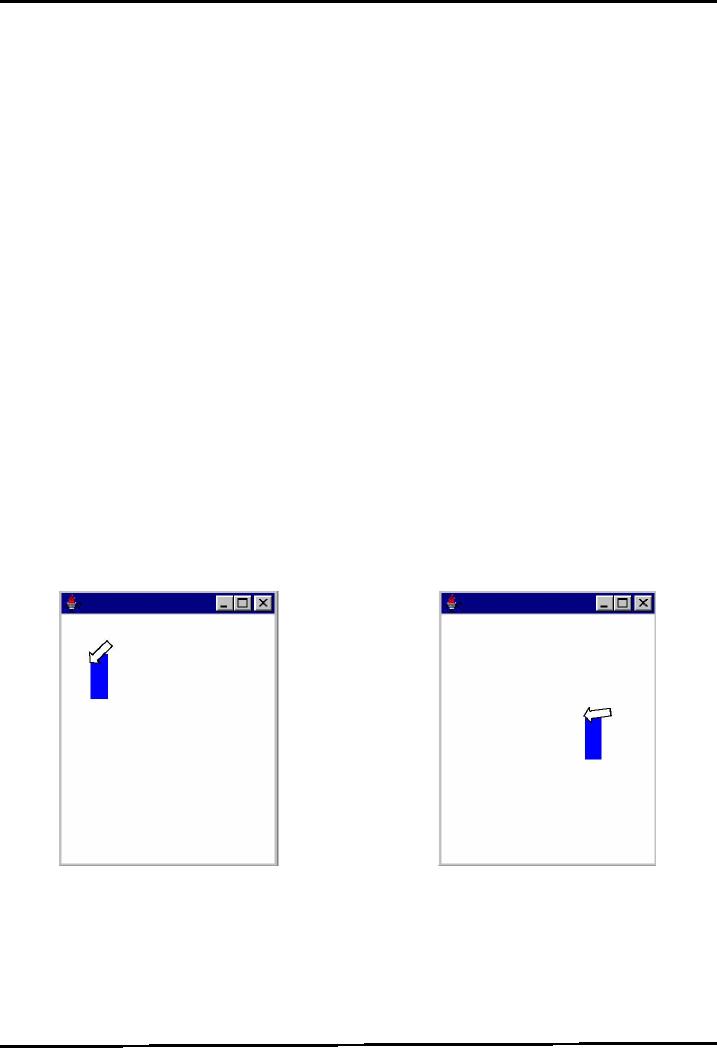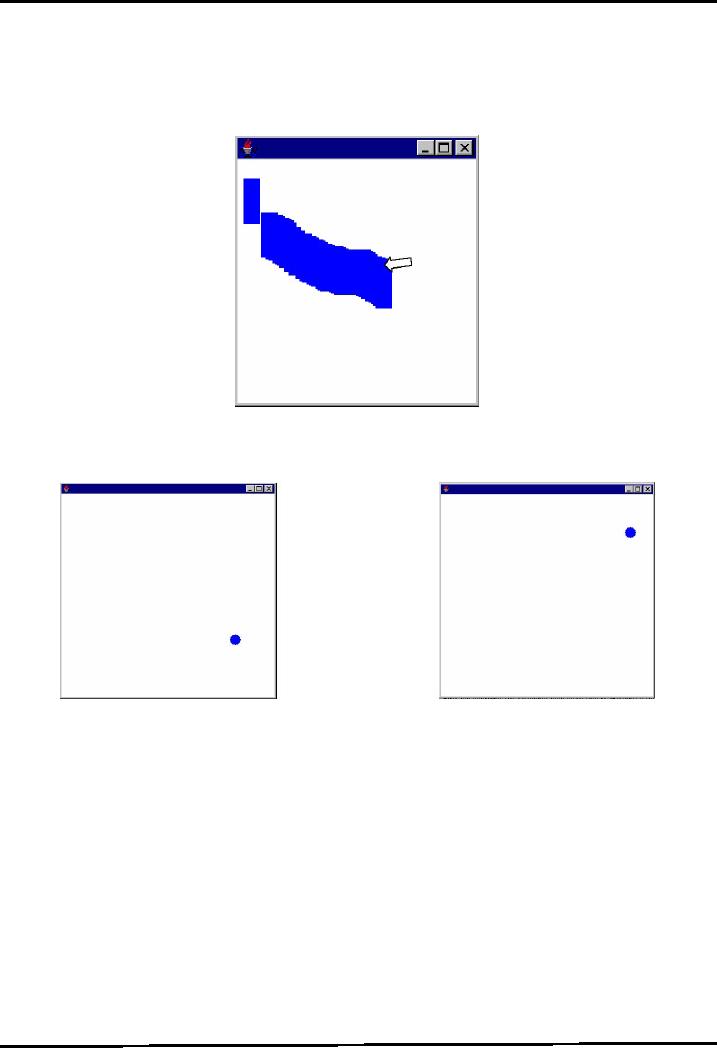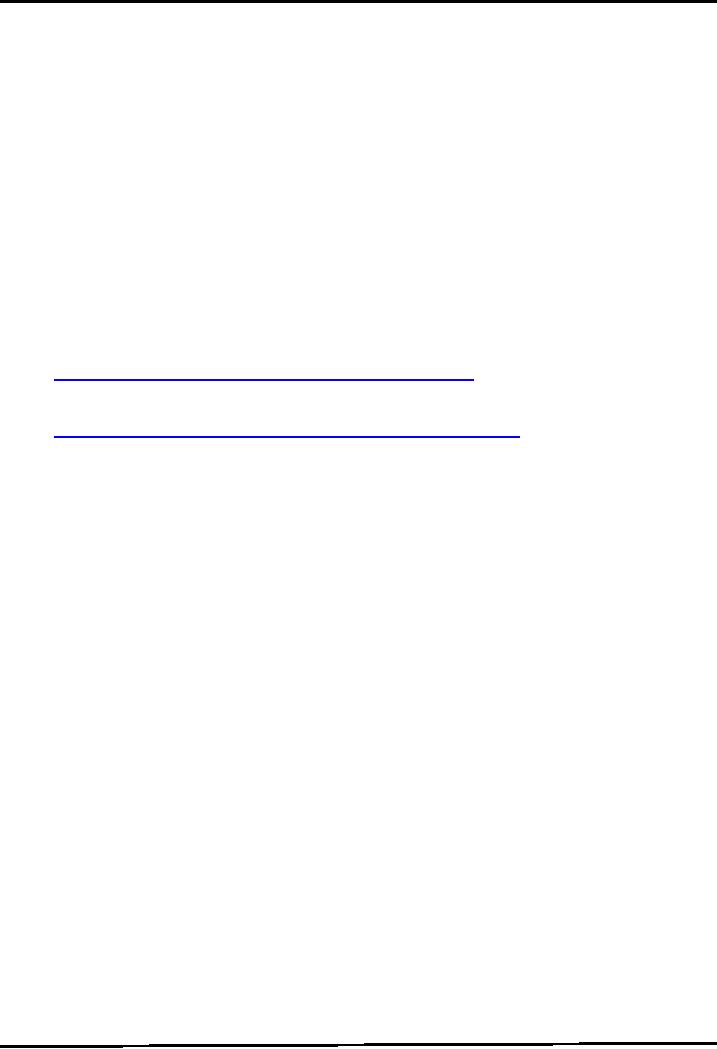 |
JAVA: How to Animate |
| << Java Graphics |
| JAVA Applets >> |

Web
Design & Development CS506
VU
Lesson
19
How to
Animate?
If we
want to animate something like
ball, moving from one place to another,
we constantly need to
call
paintComponent(
) method and to draw the shape (ball
etc.) at new place means at new
coordinates.
Painting
is managed by system, so calling
paintComponent() directly is not
recommended at all.
Similarly
calling
paint( ) method is also not
recommended. Why? Because
such code may be invoked at
times when
it is
not appropriate to paint --
for instance, before the component is
visible or has access to a
valid
Graphics
object.
Java
gives us a solution in the from of
repaint( ) method. Whenever we need to
repaint, we call this
method
that
in fact makes a call to
paint( ) method at appropriate
time.
Problem
& Solution
What
to do to move the shapes present in
example code 18.1 (last
example) when a mouse
is
dragged
First
time painting is what we
already have done
When
a mouse is clicked find the co-ordinates
of that place and paint Rectangle at that
place by
requesting,
using repaint() call
Here
instead of Hard-coding the position of co-ordinates
uses some variables. For
example mx, my
In the last
example code, we draw a rectangle by
passing hard-coded values like 20
g.drawRect(20,20,20,20);
Now, we'll use
variables so that change in a
variable value causes to
display a rectangle at a
new
location
g.drawRect(mx,my,20,20;
Similarly,
you have seen a tennis game
(during lecture). Now, what
to do code the paddle
movement.
In the
coming up example. We are
doing it using mouse, try it
using mouse.
Example
Code 19.1
The
following outputs were produced when
mouse is dragged from one location to
anther
First
we examine the MyPanel.java class
that is drawing a filled
rectangle.
import
javax.swing.*;import java.awt.*;
//
extending class from
JPanelpublic class MyPanel
extends JPanel {
//
variables used to draw
rectangles at different//locations
int mX
= 20;
144

Web
Design & Development CS506
VU
// erasing
behaviour this will clear
all the// previous painting
super.paintComponent(g);
//
Down casting Graphics object to
Graphics2D
Graphics2D
g2 = (Graphics2D)g;
//
changing the color to
blue
g2.setColor(Color.blue);
//
drawing filled oval with
color i.e. blue// using
instance variablesg2.fillRect(mX,mY,20,20);
}// end
paintComponent
The
Test class is given below.
Additionally this class also
contains the code for handling
mouse events.
//
importing required packagesimport
javax.swing.*;import java.awt.*;
public
class Test {
JFrame
f;
//
declaring Reference of MyPanel
class
MyPanel
p;
//
parameter less constructor
public
Test(){
f =
new JFrame();
Container
c = f.getContentPane();
c.setLayout(new
BorderLayout());
//
instantiating reference
p = new
MyPanel();
//
adding MyPanel into
container
c.add(p);
f.setSize(400,400);
f.setVisible(true);
f.setDefaultCloseOperation(JFrame.EXIT_ON_CLOSE);
//
creating inner class
object
Handler
h = new Handler();
//
registering MyPanel to handle
events
p.addMouseMotionListner(h);
} // end
constructor
//
inner class used for
handling events
public
class Handler extends
MouseMotionAdapter{
//
capturing mouse dagged
events
public
void mouseDragged(MouseEvent
me){
//
getting the X-Position of mouse and
assigning// value to instance
variable mX of MyPanel
class
p.mX =
me.getX();
//
getting the Y-Position of mouse and
assigning// value to instance
variable mX of MyPanel
class
p.mY =
me.getY();
//
call to repaint causes rectangle to be
drawn on// new
location
p.repaint()
;
} // end
mouseDragged
} //
end Handler class
//
main method
public
static void main(String args[ ]){
Test
t = new Test();
}
145

Web
Design & Development CS506
VU
} //
end MyPanel class
On
executing this program, when
you drag mouse from one
location to another, rectangle is also in
sink
with
the movement of mouse. Notice that
previously drawn rectangle is erased
first.
If we
exclude or comment out the
following line from MyPanel
class
super.paintComponent(g);
Dragging
a mouse will produce a similar
kind of output shown
next
Example
Code 19.2: Ball
Animation
The
ball is continuously moving
freely inside the corner of the frames.
The sample outputs are
shown
below:
First
we examine the MyPanel.java class
that is drawing a filled
oval.
import
javax.swing.*;import java.awt.*;
146

Web
Design & Development CS506
VU
}//
end paintComponent
} end of
MyPanel class
The
Test class is given below.
Additionally this class also
contains the code for handling
mouse events.
//
importing required packagesimport
javax.swing.*;import
java.awt.*;Import
java.awt.event.*;
public
class AnimTest implements
ActionListener {
JFrame
f;
MyPanel
p;
//
used to control the direction of
ball
int x,
y;
public
AnimTest(){
f =
new JFrame();
Container
c = f.getContentPane();
c.setLayout(new
BorderLayout());
x =
5;
y =
3;
p =
new MyPanel();
c.add(p);
f.setSize(400,400);
f.setVisible(true);
f.setDefaultCloseOperation(JFrame.EXIT_ON_CLOSE);
//
creating a Timer class
object, used for
firing
// one or more
action events after a
specified delay
//
Timer class constructor requires time
in
//
milliseconds and object of class
that handles
//
action events
Timer t
= new Timer (5,
this);
//
starts the timer, causing it to
start sending// action
events to listeners
t.start();
} // end
constructor
//
event handler method
public
void actionPerformed(ActionEvent
ae){
// if
ball reached to maximum
width of frame minus// 40 since
diameter of ball is 40 then
change
the//
X-direction of ball
if
(f.getWidth()-40 == p.mX)
x =
-5;
// if
ball reached to maximum
height of frame
// minus 40
then change the Y-direction of
ball
if
(f.getHeight()-40 == p.mY)
y =
-3;
// if
ball reached to min. of
width of frame,
//
change the X-direction of
ball
if
(p.mX == 0 )
x =
5;
// if
ball reached to min. of
height of frame,
//
change the Y-direction of
ball
147

Web
Design & Development CS506
VU
if
(p.mY == 0 )
y =
3;
//
Assign x,y direction to
MyPanel's mX & mY
p.mX +=
x;
p.mY +=
y;
//
call to repaint() method so that
ball is drawn on// new
locations
p.repaint();
} //
end actionPerformed() method
//
main method
public
static void main(String args[ ]){
AnimTest
at = new AnimTest();
}
} //
end of AnimTest class
References:
Java,
A Lab Course by Umair
Javed
Painting
in AWT & Swing
http://java.sun.com/products/jfc/tsc/articles/painting/index.html
Performing
Custom Painting
http://java.sun.com/docs/books/tutorial/uiswing/14painting/index.html
148
Table of Contents:
- JAVA FEATURES
- Java Virtual Machine & Runtime Environment
- Learning Basics of JAVA
- JAVA: Object Oriented Programming
- JAVA: Inheritance
- JAVA: Collections
- JAVA: Intro to Exceptions
- JAVA: Streams
- JAVA: Modification of Address Book Code
- JAVA: Graphical User Interfaces
- JAVA: Event Handling
- JAVA: More Examples of Handling Events
- JAVA: Problem in Last Code Example
- Java Database Connectivity
- JAVA: More on JDBC
- JAVA: Result Set
- JAVA: Meta Data
- Java Graphics
- JAVA: How to Animate
- JAVA Applets
- JAVA: Socket Programming
- JAVA: Serialization
- JAVA: Multithreading 1
- JAVA: Multithreading 2
- JAVA Web Application Development
- Java Servlets
- JAVA: Creating a Simple Web Application in Tomcat
- JAVA: Servlets Lifecycle
- JAVA: More on Servlets
- JAVA: Dispatching Requests
- JAVA: Session Tracking 1
- JAVA: Session Tracking 2
- JAVA: AddressBook Case Study Using Sevlets
- Java Server Pages 1
- JavaServer Pages 2
- Java Server Pages 3
- JAVA: JSP Action Elements and Scope
- JAVA: JSP Custom Tags
- JAVA: MVC + Case Study
- JAVA: MVC Model 2 Architecture
- JAVA: Layers and Tiers
- JAVA: Expression Language
- JAVA: JavaServer Pages Standard Tag Library (JSTL)
- JAVA: Client Side Validation & JavaServer Faces (JSF)
- JAVA: JavaServer Faces